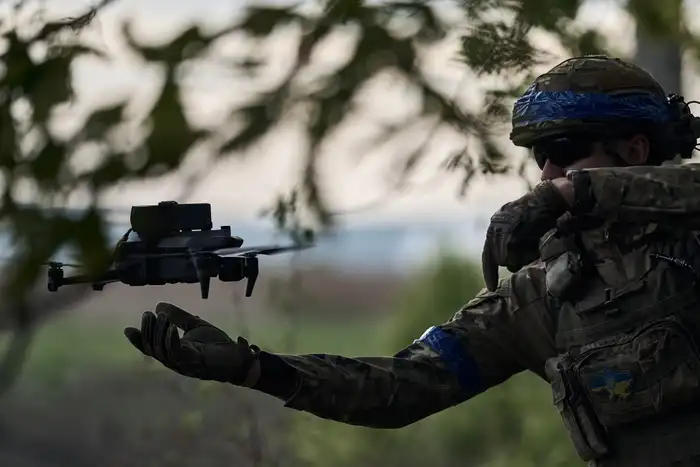Russia’s exploding unjammable drones probably won’t be the end-all game changer in this strange Ukraine war arms race

Ukrainian military personnel learn to fly drones with bombs attached at a special school in May 2023 in the Lviv region of Ukraine.
Russia’s using newer drones guided by fiber-optic cables that make them immune to the kind of signal jamming and electronic warfare that’s plagued both sides’ use of unmanned systems.
The latest adaptation in unmanned warfare isn’t necessarily an end-all game changer, though. Rather, the wired drones are most likely just another evolution in the ever-expanding drone arms race between Russia and Ukraine. Rarely in war is something a true silver bullet.
Since Ukraine’s surprise invasion of Russia’s Kursk region, reports have repeatedly surfaced highlighting the employment of new wired unmanned aerial vehicles by Russian forces to target Ukrainian military vehicles like tanks and personnel carriers.
Footage shared on social media via open-source intelligence accounts has also documented the drones being used in combat. The tell in the video is the higher-quality picture compared to the wireless systems.
How the Russian FPV drones “Knyas Vandal of Novgorod” (KVN) deal with the invaders in the Kursk area. This is only for yesterday and the day before yesterday. pic.twitter.com/BYpZsrdVUF
— nofm_geopolitics (@nofmgeopolitics) August 13, 2024
Russian military Telegram channels have shared footage of apparent uses, writing that the drones were “controlled via a fiber-optic cable, which ensures its high accuracy and resistance to electronic warfare.”
Drones immune to jamming
The first documented use of the fiber-optic drones was back in March, when Ukraine recovered a Russian prototype, but the usage of these weapons appears to be more pervasive now.
The fiber-optic wire on the drone effectively preserves a stable connection between the drone and the operator, resisting radio jamming and electronic warfare and ensuring a high-quality video transmission so that the pilot can see where they’re flying.
As the drone flies, its cable is unwound from a reel attached the drone.
Various companies, including German and Chinese companies have been working on fiber-optic drones. The German company HIGHCAT, for instance, plans to test its fiber-optic drone in Ukraine sometime this month, according to United24, a Ukrainian government-run operation that’s crowdfunding to develop and build drones for the war.
Stacie Pettyjohn, director of the defense program at the Center for a New American Security, explained that it’s currently hard to judge the effectiveness of these systems based on the select subset of information found online, but their employment makes sense given the impact of jamming on drones.
It’s just one of the ways, though, that Russia and Ukraine have been adapting to that problem.
More than one way to solve a problem
“There are two ways that both countries are trying to respond to this,” Pettyjohn said. The low-tech, inexpensive solution is something like this new wired drone, “tethering it to a guidance system that can’t be disrupted.”
The design is similar in some ways to weapons like the widely available US-made anti-tank TOW missile, which is a wire-guided system that allows the operator to maintain a connection, change flight paths, and ensure the missile meets its target.
The high-tech solution to the jamming problem revolves around using an autonomous terminal guidance system, effectively making the drone a “fire-and-forget” weapon because it’s been locked onto a target should jamming disable the connection between the operator and the drone. It also doesn’t require as much skill from a pilot because of that lock-on capability. There are strong indications the next stage in drone warfare may be here.
Both options have pros and cons, Pettyjohn said. But the wired drone has a number of potential drawbacks.

US Army drones at a military base in Poland.
First, the operator needs to consider how they are using the wired drone. The drones being used with this type of connection are already typically short-range tactical drones, but the cable adds an additional range constraint. The tethered drones are also likely compact and probably carrying smaller payloads.
Pettyjohn said that “when you add the additional weight and the complexity of having a leash that’s attached to the drone, there’s only so far it’s going to be able to go.”
The attached wire may also restrict where the operator can fly the drone. It could, for example, get snagged on tree branches or potentially become entangled with other wired drones. And possible counters, such as severing the wires, could also limit the system’s usefulness in combat.
HIGHCAT has said its wire drops to the ground once it’s unwound from its reel, “which eliminates the possibility of tangling.” It’s unclear if the Russian systems adequately address this issue or not.

A pilot of the “Sharp Kartuza” division of FPV drones preparing a drone for a combat flight in the Kharkiv region, Ukraine.
But any concerns about the downsides of the wired drones doesn’t mean they won’t be useful. There are videos of these weapons striking targets and dealing damage.
A drone arms race
Soldiers fighting along the front lines in Ukraine, where combat within the electromagnetic spectrum is significant, may see the value of maintaining a wired connection with their drone to resist jamming and ensure they can hit a short-range target.
Drone losses to electronic warfare have been tremendous, so the advantages of the tether potentially outweigh the disadvantages. The jamming threat is likely far more of a concern than getting them hung up in a tree.
HIGHCAT co-founder Jan Hartmann recently said that the fiber-optic drones developed by the company were “designed with the frontlines in mind, in particular, the current developments in Ukraine. We wanted to create a COTS (Commercial Off The Shelf) system that wasn’t jammable by enemy combatants.”
It’s more likely, though, that this type of technology will just become another option in Russia and Ukraine’s tool boxes as the drone development race continues, Pettyjohn said.
First-person-view, or FPV, drones began emerging as a notable battlefield threat in Ukraine. They started out as surveillance tools or assets for adjusting fire but quickly evolved into something more, specifically precision-strike options.

An FPV unit in the Ukrainian army launches one-way attack drones at the positions of the Russians in Kupiansk, Ukraine.
From there the technology expanded. Drones were used to drop mines or grenades, slam into vehicles or troop positions with explosives on board, or even intercept other drones, such as the bigger, more exquisite systems.
Electronic warfare has taken its toll on the force, but now new things, like the wired drones, are emerging. At some point, as countermeasures are developed, some other capability will most likely take its place. Maybe it’s AI-driven autonomous drones. Perhaps it is something else. Ukrainian officials have said unmanned ground combat systems could be the next “game changer.”
Both sides continue to engage in a cat-and-mouse game, adapting and countering each others’ latest developments. And as a Ukrainian official previously told B-17, “this is the most technologically advanced war in human history.”
“Technologies make a difference on the battlefield,” the official explained, saying “we are basically re-inventing their use every day.”






